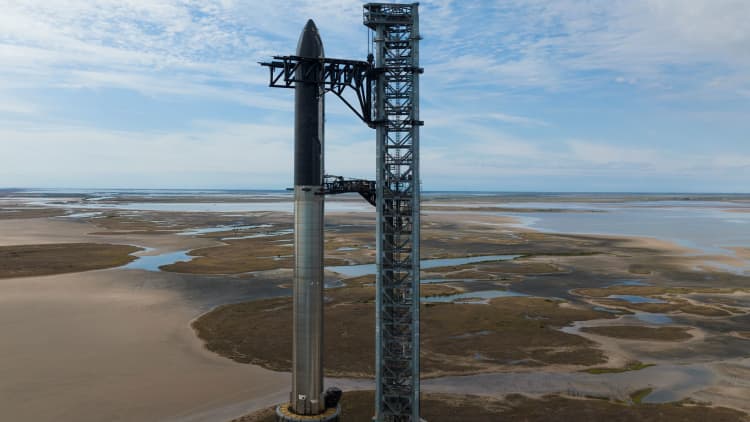[ad_1]
SpaceX’s next-generation Starship spacecraft, atop its powerful Super Heavy rocket, lifts off for its third launch from the company’s Boca Chica launch pad on an uncrewed test flight near Brownsville, Texas, United States, March 14, 2024.
Cheney Orr | Reuters
The Federal Aviation Administration could issue SpaceX its next Starship license in time for a launch attempt Sunday, CNBC has learned.
SpaceX and its CEO Elon Musk have sharply criticized the FAA in recent weeks, urging the federal regulator to speed up its licensing review for Starship’s fifth test flight. Just last week, the FAA said it did not expect to issue the license until “late November.”
Despite the ongoing review, SpaceX has released a statement on Monday saying Starship’s fifth spaceflight “could launch as early as October 13, pending regulatory approval.” The company did not say whether it hoped to receive its license by Sunday.
But a person familiar with the matter said Tuesday that SpaceX’s apparently aggressive goal was possible because the FAA review process had accelerated.
The regulator and partner agencies involved in the process conducted assessments more quickly than expected, the person told CNBC, with the U.S. Fish and Wildlife Service in the final stages of completing a review for the FAA. The person, who asked to remain anonymous to discuss the ongoing federal review, noted that it is also possible that problems this week could prevent a Sunday attempt and push approval to the end of the month.
In an updated statement to CNBC on Tuesday, the FAA removed its earlier estimate from November.
“In mid-August, SpaceX submitted new information on its Starship/Super Heavy Flight 5 mission proposal. The FAA continues to review this information. The FAA will make a permitting decision once SpaceX has satisfied meets all licensing requirements,” the FAA said.
The Fish and Wildlife Service referred CNBC to the FAA in response to a request for comment.
On September 10, SpaceX released a long blog post claiming the FAA was delaying Starship’s fifth launch due to “unnecessary environmental analysis”, alleging the extensive review was conducted “for unreasonable and infuriating reasons” that represent difficulties in “the current regulatory environment” for companies seeking launch licenses.
The post criticized in part reports that SpaceX violated environmental regulations by using the water deluge system at the Starship launch pad in Texas without permission. However, SpaceX has paid its fines imposed by the Texas Commission on Environmental Quality and the federal Environmental Protection Agency regarding unauthorized water discharges.
Reuters first reported that the FAA could approve a license as early as this month, but did not say whether it could come as early as Sunday.
An ambitious fifth launch
The sun sets behind the SpaceX spacecraft before its fourth flight test on Boca Chica Beach June 5, 2024 in Brownsville, Texas.
Brandon Bell | Getty Images
SpaceX aims to further develop its gigantic Starship rocket with its fifth flight. It seeks to build on the progress made in June Starship’s fourth test flight – which flew halfway around the world for an intentional landing in the Indian Ocean.
As part of SpaceX’s efforts to make Starship fully reusable, the company plans to attempt to return and grab the rocket’s 232-foot-tall booster.
After being launched and separated from the upper Starship section of the rocket, the Super Heavy booster is expected to return to the launch site and land between a pair of “wands” on the tower. SpaceX stressed that the capture attempt requires “thousands” of criteria to be met, otherwise the booster will veer off course and crash off the coast of the Gulf of Mexico.
“We make no compromises when it comes to ensuring the safety of the public and our team, and return will only be attempted if conditions are right,” SpaceX said in a statement describing the flight.
The window opens at 8 a.m. ET on Sunday for the fifth Starship launch from the company’s facility near Brownsville, Texas.
Starship is both the tallest and most powerful rocket ever launched. Fully stacked on the Super Heavy booster, Starship is 397 feet tall and approximately 30 feet in diameter.
The Starship system is designed to be fully reusable and aims to become a new method of transporting goods and people beyond Earth. The rocket is also essential to NASA’s plan to return astronauts to the Moon. SpaceX won a multibillion-dollar contract from the agency to use Starship as a crewed lunar lander as part of NASA’s Artemis lunar program.


